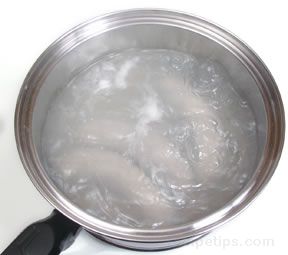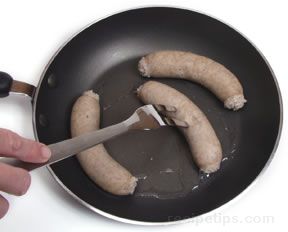Specific Types of Sausage | Cooking
Sausage
|
Sausage
|
|
|
| Sausage is a meat product generally consisting of pork, but also
made of beef, veal, lamb, poultry, or a combination of several of
these meats. Sausage meat is generally ground, mixed with other ingredients,
such as rice, cereal, soybean flour, or dried milk solids, and seasoned
with herbs and spices. The meat is preserved with additives and made
into fresh sausage to be processed for bulk use in the form of patties
or molded into a casing to be sold as sausage links, sticks, and rings.
The casing can be a natural casing made of animal intestines or an
artificial casing. The meat is then cured, air-dried, or precooked. |
There are two basic types of sausages: uncooked and ready to eat. Uncooked
sausages include fresh and smoked sausages. Ready to eat sausages include
cooked, semi-dry, and dry sausages. The following descriptions further
explain some of the sausages that are available.
|
Uncooked Sausage
|
Ready to Eat Sausage
|
| Uncooked fresh sausage: meat that has not
been cured or smoked and must be cooked prior to serving, which is
sold as bulk, patties, or links. Uncooked fresh sausages include fresh
Bockwurst, Bratwurst, fresh Pork Sausage, Italian-style fresh Pork
Sausage, Salsiccia, Weisswurst, and fresh Thuringer.
Uncooked smoked sausage: meat that has been cured or smoked, that
requires cooking prior to serving. Country style smoked pork sausage,
Linguica, Mettwurst, and Polish sausage are included in this category.
|
Cooked Sausage: meat that has not been
cured or smoked, but has been precooked. Blood sausage, cooked Bockwurst,
Braunschweiger, cooked Bratwurst, Liver sausage, and cooked Thuringer
are included in this group of sausages.
Cooked smoked sausage: meat that has been cured, lightly smoked,
and precooked. Bologna, Boterhamworst, Bratwurst, Frankfurters,
Knackwurst, precooked varieties of Polish sausage, and Berliner
or New England style sausage, Smokies, Vienna sausages, and Wieners
are examples of this type of sausage.
|
|
Dry Sausage
|
Specialty Sausage
|
|
Dry sausage: meat that has been cured and air-dried, making it
ready to serve either cold or warm. There are semi-dry and dry sausage
categories. Semi-dry sausages are generally partially dried, but
sufficiently heated to cook the sausage. Semi-dry sausages include
Cervelat, Lebanon Bologna, Mortadella, and Vienna. Dry sausages
can be smoked, unsmoked, or cooked, and include Chorizo, Frizzes,
Lyons, Pepperoni, Salami, and Soppressata.
|
There are also specialty sausage meats available, which are meats
that have been cooked and processed into sticks or loaves for slicing,
such as Beef Loaf, Goetta, Headcheese, Pickle and Pimento Loaf,
and Scrapple.
|
Types of Sausage
Abruzzese Sausage | Andouille
Sausage | Bauerwurst Sausage | Blood
Sausage
Blutwurst Sausage | Bockwurst
Sausage | Boudin Blanc Sausage
Bratwurst Sausage | Chaurice
Sausage | Chipolata Sausage
Chorizo Sausage | Cotechino
Sausage | Kielbasa Sausage
Polish Sausage | Turkey Bratwurst
| Turkey Sausage
| Abruzzese
Sausage
A dry Italian sausage made from choice cuts of fresh pork that
are combined with natural seasonings and cured with smoke and chili
pepper. This meat can be served as a topping on pizzas, as meat
for main dishes, or as an appetizer.
|
Abruzzese Sausage
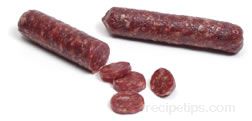
|
| Andouille
Sausage
A course-grained smoked meat made with pork, chitterlings, pepper,
wine, onions, and seasonings. French in origin, but brought to Louisiana
by German and French immigrants, this sausage is most often associated
with Cajun cooking. It is produced in two main varieties: a mild
sausage (French in origin) and a spicier, Cajun version (derived
from French influence) that is used as an ingredient for various
Cajun foods such as soups, stews and meat dishes. There are a number
of versions produced that generally provide a spicy, smoky, rich,
earthy flavor, which may also have a slightly sweet taste. Andouille,
which has a noticeable flavor of herbs and garlic, is used as an
ingredient in meat dishes, as an appetizer, and is especially well
suited for jambalaya or gumbo. Tasso, also known as Cajun ham, can
sometimes be substituted for Andouille, but if combined in a main
dish, it may not offer the distinct flavors of Andouille and may
also add too much of a smoky flavor to the food. Andouilettes, which
are generally 1 inch or less in diameter, are smaller versions of
Andouille sausage.
|
Andouille Sausage
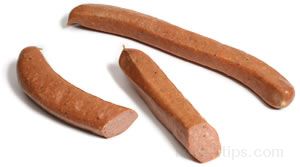
|
| Bauerwurst
Sausage
A plump, mildly flavored sausage that is often served like a hot
dog sandwich. Since the sausage is German in origin, it is also
a popular accompaniment to sauerkraut.
|
| Blood
Sausage
A large link sausage that is typically made of pork, seasoned pork
blood, suet, breadcrumbs, and oatmeal, although other ingredients
may be added. It is generally precooked, somewhat open textured
and dark crimson to black in color. This type of sausage may also
be referred to as blood pudding or black pudding as it is in Ireland;
however a true blood sausage will have less cereal as an additive,
less seasoning, and will always be made with pork blood as an ingredient.
Blood sausage can be eaten raw, since it is precooked, or fried,
or added to soups, stews, and main dishes.
Blood sausage is produced in a number of different varieties in
numerous regions of the world. Germany produces blutwurst, which
is made of pig's lungs, chopped bacon, and various seasonings. In
Spain, morcilla is a typical blood sausage that contains pig's blood,
suet, and seasonings. It is produced as a heavily smoked meat or
as a somewhat sweet and spicy meat. A Polish-American version of
blood sausage is referred to as kishka, which is made with blood,
beef and barley to be served as a breakfast sausage. Other names
for this sausage that may be used are kiska, kiske, kishke, kiszka,
der ma, and stuffed derma. Since each region has their own version
of blood sausage, there will be a wide variety of ingredients used
for making the sausage, which will cause it to vary in taste and
texture.
|
Blood Sausage or Kishka
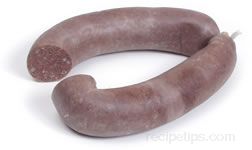
|
| Blutwurst
Sausage
A German sausage that is made with ground bits of pork, beef, beef
blood, and seasonings. It is a spicy precooked sausage, but it is
usually heated again before serving to provide optimum flavor.
|
| Bockwurst
Sausage
A type of sausage traditionally made from ground veal and pork
(usually more veal than pork), with milk and eggs added, that may
be seasoned with chives and parsley. The mixture is finely ground
and packed into a thin sheep's casing. German in origin, this sausage
is pale in color before being cooked and becomes tan colored after
being cooked. Indicative of its light coloring when made fresh,
bockwurst is also known as Weisswurst, translated to mean white
sausage. Although sold as a partially cooked or smoked sausage,
it is typically sold raw or fresh, so it is important that it be
thoroughly cooked or smoked before it is eaten. To prepare, heat
the sausage in water that is boiling lightly until it is thoroughly
cooked, which is typically 10 or 15 minutes. In addition to boiling,
it can be fried or grilled, cooking it on all sides until golden
brown. If fried or grilled, slit the casing in several locations
to allow the casing to expand as it cooks without breaking apart.
To store, keep the fresh sausage refrigerated and use within several
days as it is highly perishable and will spoil easily. It is a sausage
that goes well with cabbage, sauerkraut, fried potatoes, dark heavy
breads, seasoned mustard, and beer.
|
Bockwurst

|
|
Boudin Blanc Sausage
A mildly flavored sausage that can be made with pork, veal, or chicken
with the addition of rice as a filler, giving the sausage a pale
color. The French version of the sausage includes milk as an ingredient,
while a Louisiana version uses additional rice.
|
| Bratwurst
Sausage
A type of German sausage made of pork or a combination of pork
and veal with spices and herbs. It is usually purchased fresh, so
it must be thoroughly cooked before it can be eaten. It is popular
when grilled, fried, or broiled.
|
Bratwurst Sausage

|
| Chaurice Sausage
A type of pork sausage that is Creole/Cajun in origin and has a
hot and spicy flavor. Chaurice is popular in Creole/Cajun cooking
both as a main dish and as an ingredient in dishes such as gumbo
and jambalaya.
|
| Chipolata
Sausage
A small highly seasoned pork sausage native to Mexico.
|
| Chorizo
Sausage
A coarsely ground dry pork sausage that is heavily seasoned, smoked,
and produced into links that range in size from small to jumbo frank.
When produced in Mexico, this spicy sausage is uncooked and made
from fresh pork. The Spanish product, which is also very spicy,
is produced from smoked pork that is dry-cured.
|
Chorizo Sausage
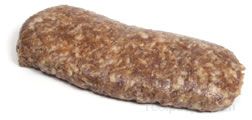 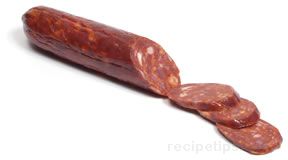
|
| Cotechino
Sausage
An Italian fresh pork sausage that has a creamy, mild flavor. It
is usually produced in links under a foot long with a diameter of
nearly three inches. Clove and nutmeg seasonings give the sausage
a unique flavor. It is often boiled and served with potatoes and
beans or added to soups and stews.
|
| Kielbasa
Sausage
Often referred to as Polish sausage (which is uncooked), Kielbasa
is a precooked smoked sausage that is highly seasoned with ingredients
such as garlic and then produced in links or rings that are approximately
1" to 2" in diameter. The traditional kielbasa was most
often made only of pork, but it is now produced as a combination
of both lean pork and beef or with turkey.
|
Kielbasa Sausage
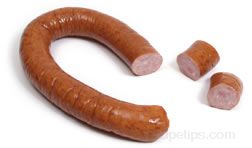
|
| Polish
Sausage
A type of sausage that is made with processes and ingredients typical
of those used to make Poland's "kielbasa" (sausage). It
may consist of coarsely chopped pork or a combination of coarsely
chopped pork and finely chopped beef, seasoned with garlic, pepper,
nutmeg, and possibly mace. The ingredients are mixed thoroughly,
packed in a casing, dried, and then smoke-cured. The Polish sausage
available in many food stores today may range from bratwurst that
is 7 inches long to a ring of sausage that is almost 24 inches long.
Precooked Polish sausage can be served as an appetizer or mixed
into other food ingredients, while other non-cooked varieties require
cooking on a grill or in an oven before serving.
|
Kolbase Polish Sausage
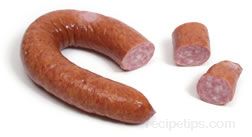
Kielbasa Polska Sausage

|
| Turkey Bratwurst
A sausage made with ground turkey and a combination of several
spices, such as caraway, nutmeg, and ginger. Traditional bratwurst,
which is German in origin, is made with pork and veal. Turkey bratwurst
is a popular alternative to traditional bratwurst because of its
low fat content. It is most often available fresh, so it must be
well cooked before it is served. Turkey bratwurst is best when it
is grilled, fried, broiled, or baked.
|
Turkey Bratwurst
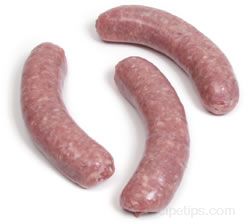 |
| Turkey Sausage
A variety of lean sausage made from turkey meat and a mixture of
fat, salt, and seasonings. A variety of sizes are available ranging
from small link size portions to rings of sausage measuring approximately
12 inches in length. Turkey sausage is produced in various flavors,
such as smoked, Italian, or hot and spicy, and may be available
as cooked or uncooked meat. It can be served in sandwiches, soups,
chili, on pizza, with pasta, in stratas, or with a variety of other
types of foods.
|
Turkey Sausage
 |
Cooking Sausage
Poaching | Pan
Frying | Grilling
| If cooking fresh sausages, it is best to poach them for a few minutes
before cooking to ensure that they will get fully cooked without the
outer layer becoming over done. Once they have been poached, cook
them in the same manner as the precooked sausages. Do not pierce the
sausages until after they have been poached, too much of the fat may
escape while poaching, causing the sausages to be dry. |
|
|
| Poaching is a good method to use to precook fresh sausages
before finishing the cooking process with another method, such as
frying, grilling or broiling. |
|
|
To poach fresh sausage, bring water in a sauce pan to
a boil and then add the uncooked sausages. |
|
|
Reduce the heat to a gentle simmer and cover. Cook
for approximately 10 minutes and then finish cooking and browning
them by frying, grilling or broiling. |
|
|
|
Sausages can be cooked using the pan-frying method.
If they are precooked sausages, they can be placed in an unheated
frying pan and cooked until nicely browned and heated to an internal
temperature of 140°F.
|
|
|
|
|
Place sausages in an unheated frying pan. Add a
small amount of oil or pierce the casing of the sausage to allow
the sausages to release some of their own fat while they are cooking.
|
Fry sausages on medium low heat until all sides
are evenly browned. If sausages were not pierced when cooking began,
pierce the casing while frying to prevent casings from splitting
open.
|
|
If they are fresh sausages, it is best to poach
them for a few minutes before frying to ensure that they will get
fully cooked without the outer layer becoming over done. Once they
have been poached, fry them in the same manner as the precooked
sausages. Do not pierce the sausages until after they have been
poached and are in the frying pan, otherwise too much of the fat
may escape while poaching, causing the sausages to be dry.
|
|
|
| Sausage requires direct heat to seal the outside and
indirect heat to allow the sausage to cook thoroughly to the center.
Sear with Direct heating, continue with Indirect fire until done.
To be safe, poach uncooked sausage before placing on grill. |
 |
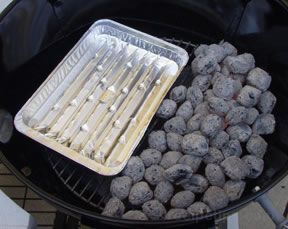 |
 | | Copyright 1999-2025 - Tecstra Systems Corporation/RecipeTips.com - All Rights Reserved |
|












